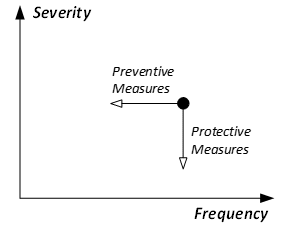Last edit: 24/06/2024
In general, Risk Reduction happens through both
- Preventive measures, which reduce the frequency, and
- mitigating or Protective measures, which reduce the severity,
as shown in the figure 
The operation of cutting trees in a forest is an example of a Preventive measure since it prevents fires to spread. On the other hand, a fire detector is an example of a Protective Measure since it cannot reduce the frequency at which a fire occurs, but it can reduce the severity of consequences by initiating a sprinkler system.
Preventive measures reduce the likelihood of the dangerous event, while protective measures reduce the severity of the damage: Personal Protective Equipment are an example of the latter.
The use of glycolic water in Forging Presses, instead of oil, is another example of a preventive measure, since it reduces the likelihood of fires in case a pipe breaks off.
The creation of a safeguarded space with an interlocked door and an AOPD, is defined in the ISO 12100: 2010 as a Protective Measure.
ISO 12100 [41]. 3 Terms and definitions
3.19 Protective Measures. Measures intended to achieve risk reduction, implemented:
- by the designer (inherently safe design, safeguarding and complementary protective measures, information for use) and/or
- by the user (organization: safe working procedures, supervision, permit-to-work systems; provision and use of additional safeguards; use of personal protective equipment; training)

ISO 12100 requires a Risk assessment.
The risk is linked to both the Severity and the Probability of the event
R = S * P
Let’s suppose we give the following estimation for a specific Hazard:
- S = 3 (Breaking a limb)
- P = 12 (Hybrid Method of ISO TR 14121-2)

As a solution, we propose to create a safeguarded space defined by
- Movable Guards
- AOPD
Considering those Protective measures, we now need to reassess the risk and judge if it was reduced to an acceptable level.
In this second iteration, there are people who now consider a lower severity, like S = 1 (first aid)
That is not correct! The protective measure we want to implement reduces only the probability to be close to a moving robot and not the severity of the harm, in case the robot has an unexpected movement (start up). But, the person who did the second iteration may say, in his defence, a Protective Measure, by definition, reduces the severity!
It’s a mess!
Exactly for that reason, in the new edition of ISO 12100, that will see the light in 2026, the term Protective Measure (mentioned 96 times in the 2010 edition!) will be replaced by a new term:
Risk Reduction Measure
Risk Reduction Measures are means to eliminate hazards or reduce risks. Therefore, glycolic water in Forging Presses is a type of Risk Reduction by Inherently Safe Design, while a safeguarded space with an interlocked door is a type of Risk Reduction by Safeguarding.
Let’s consider a robot inside a safeguarded space; the damage in case it starts unexpectedly does not change, compared to a situation whereby the robot operates in an open area. However, since the Safety-related control System that keeps the robot in a “Safety-Related Stop” when a gate is open, has a low probability of failure, the likelihood that a person gets injured is reduced, even if it is not impossible.
Therefore, the use of a Safety-related control system reduces the probability of the event, but not its Severity. That is valid for most of the Risk Reduction Measures applied in Machinery Safety.